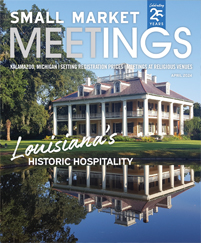Bigger isn’t always better. Small meetings, those with 100 or fewer attendees, often need a little more help than larger conferences, but they also have more opportunities. Small meetings can squeeze into historic off-site venues, distinctive lodging options and one-of-a-kind tours of which larger events would simply be too big to take advantage.
More Help, Smaller Budgets
A small meeting often doesn’t have its own dedicated meeting planner, or the person planning the event is a volunteer, in need of a little more help and guidance in the planning.
“It’s not a bad thing, but they ask more questions,” said Kate Kane, director of sales for the Clark-Floyd Counties Convention and Tourism Bureau, the agency that represents the southern Indiana cities of Jeffersonville, Clarksville and New Albany, just across the river from Louisville, Kentucky. “It’s a little more hand holding.”
In those cases, the CVB offers more of a concierge service between the group and the hotel, site or attraction by helping with leads and negotiations, Kane said.
In addition to relying more on CVB services and needing more assistance with things like spousal programs, speaker selection, site visits and several other services to promote increased attendance, small meetings often have to be more budget conscious, said Kim DaRoja, convention sales manager for the Myrtle Beach Area Convention and Visitors Bureau in South Carolina.
As part of watching the budget, many small meetings stay fairly local or stick to drive-in destinations. For Altoona and Blair County, Pennsylvania, “a lot of attendees find us to be a central place to travel to,” said Mark Ickes, executive director of Explore Altoona, the CVB for Blair County.
“The value of this market to a lot of meeting planners is that we’re extremely cost effective, and we’re within a two- or three-hour drive,” Ickes said.
Small meetings often opt for smaller cities because of their budgets, but another advantage for those events is feeling like a “big fish in a little pond,” DaRoja said. In large cities or at large venues, a 100-person event may feel “lost in the noise,” but such events make a big splash in a small community, she said.
Although many small meetings happen in the SMERF market, corporations are scaling down their meetings as well, DaRoja said.
“Corporations saw the need to still hold the meetings, maybe even more so because of morale; but now, instead of inviting everyone, they’re more strategically planning who this would benefit the most,” she said. “A lot of these corporations would have only looked at first-tier cities in the past, but now they have to pull off these meetings in a more economical way.”











